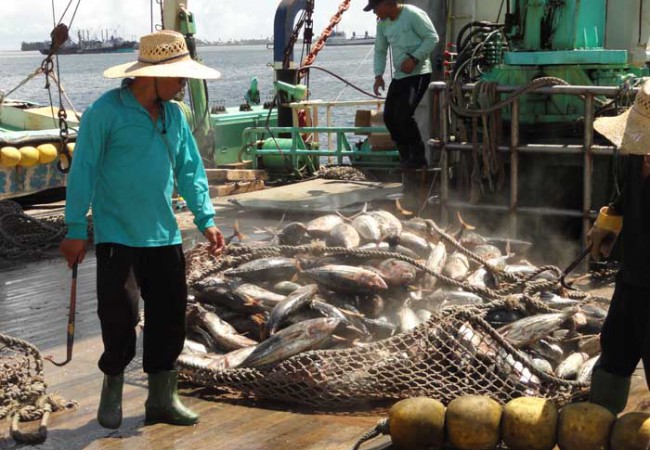
Greed trumps conservation in the Pacific
So much money is being made from the Western and Central Pacific tuna fishery that virtually no one wants to heed the message of scientists and managers whose conservation advice is falling on deaf ears. With the emergence of the Parties to the Nauru Agreement (PNA) as a major player in the region since 2010 and enforcement of its ‘vessel day scheme’, tuna revenues accruing to the eight PNA member nations have quadrupled—and is set to rise again in 2015, when the minimum fishing day fee jumps from the current US$6,000 to US$8,000.
But before we start feeling sorry for a fishing industry that is now paying four times or more than in the past to access the PNA’s rich fishing waters, consider that in 2012 the estimated total tuna tonnage caught set a record of 2.6 million tons, generating revenue in the neighborhood of US$4 billion. Skipjack tuna prices on the world market set an all-time high of US$2,300 a ton in mid-2013, and though the price plummeted from over-supply late last year and remained low earlier this year, it is heading back up and is in the US$1,500 level today.
It’s big money. In some islands, the revenue flowing from fisheries accounts for as much as a third to half of locally-generated funds for national governments. With the number of purse seiners rising from 226 in 2000 to over 300 this year, it’s obvious that the industry is cashing in, too.
‘If we want a train wreck instead of a sustainable fishery, we should keep going the way we are now’, Glenn Hurry, the outgoing Executive Director of the Western and Central Pacific Fisheries Commission (WCPFC), warned earlier this month.
Fisheries scientists will release results of a three-year Pacific tuna stock assessment in August. Hurry says the results are expected to confirm what scientists have been saying in recent years: Bigeye tuna is on the brink of being over-fished and measures adopted over the past six years to reduce catch levels have not worked; yellowfin tuna is likely at its maximum sustainable fishing level and the region could be in danger of seeing significantly reduced stock levels if ongoing heavy fishing continues unabated; and skipjack tuna, though still at healthy stock levels, is now at about 50 percent of its original biomass.
The fishery is seeing an increase in the number of boats and improved sophistication of catch technology—everything from fish aggregation devices that have tuna-tracking sonar to larger vessels with greater capacity—that add up to greatly increased pressure on the resource.
‘The news isn’t good and no one wants to hear it’, says Hurry, who leaves his post in August after four years at the head of the Pohnpei-based WCPFC. ‘We’re trying to tell people: you can’t fish at this level and expect it to last’.
Pacific islands and the PNA nations in particular—Papua New Guinea, Kiribati, Federated States of Micronesia, Solomon Islands, Nauru, Tuvalu, Marshall Islands and Palau—have the greatest interest in sustaining stocks and the ability to cap, and reduce, fishing effort in the region. But as the cash rolls into government coffers from the industry, it may get increasingly difficult to reduce fishing effort. In 2012, for example, despite the PNA members agreeing to a specific number of fishing days for each member, Kiribati continued to sell days over and above its limit. It is no secret, either, that other PNA members have skillfully managed grey areas, such as so-called ‘non-fishing days’, to their and the industry’s benefit.
And many islands now have domestic fleets of fishing vessels—either joint venture with foreign fishing companies, wholly owned, or locally flagged—that they are promoting to gain more benefits from the industry.
Simply put, the more valuable the industry gets to the islands, the more difficult it will be to reduce catch levels and the number of fishing vessels at work in the Pacific.
PNA earlier this year set 44,623 as the limit for fishing days in 2014 and 2015. A number of PNA members are expected to exhaust their allotted share of days before the end of year, a development that under PNA rules will require them to close their EEZs to fishing. The Solomon Islands and other countries have closed their EEZs to fishing in recent years when they ran out of days—action that is a ‘best practice’ because it both conserves the resource and increases the value of days, but is nevertheless difficult to do because of money to be made by selling more days.
One important mechanism for maintaining PNA-established fishing day limits is PNA’s trading scheme. The concept is that if one member sells all its fishing days, it can buy days off other members so that fishing can continue in their zones. If migratory tuna are not in the waters of the Marshall Islands, for example, it may not be able to sell all of its fishing days. If tuna fishing is heavy in, for example, PNG and the Solomon Islands, they may need additional days so that fishing can continue. By purchasing days from members who have them, PNA can remain within its overall fishing day limit, while maintaining value through the trading system for members whose zones are not being fished. The fishing day trading system has been used on and off over the past three years, and clearly has an important future role if overall fishing limits are to be maintained.
Still, history is not on the Pacific’s side. Throughout the world, one fishery after another has crashed, throwing fishermen out of jobs and causing economic chaos as well as loss of important food sources.
Knowledge is power, but can it trump increasing fisheries revenue? That is the key challenge facing the Pacific islands today as they attempt to both control and gain more benefit from the lucrative tuna fishery.

